Perception Horizons on Fingers ™
Epigraph
The horizon is an incomprehensible line where the waves close in, agreeing with the sky to keep a secret
Mechanical Shower Engineer

As you know, the story develops in a spiral. Even Lenin said so, and before him Hegel, and before him, surely, many more, because the thought is quite obvious and even a little captain. After all, a spiral is a closed cycle, it is a circle, only, if I may say so, unfolded in time .
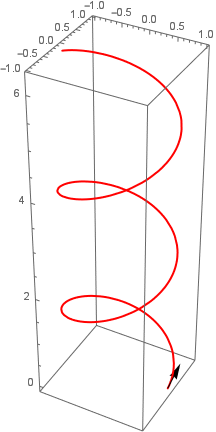
The circle developed in time turns into a spiral (more precisely, helix)
The history of the accumulation and systematization of human knowledge (today the complex of such events is called “science”) also develops in a spiral, that is, we return again and again to similar questions and (most importantly) to similar answers to the same questions. Only at an ever higher level of knowledge and understanding.
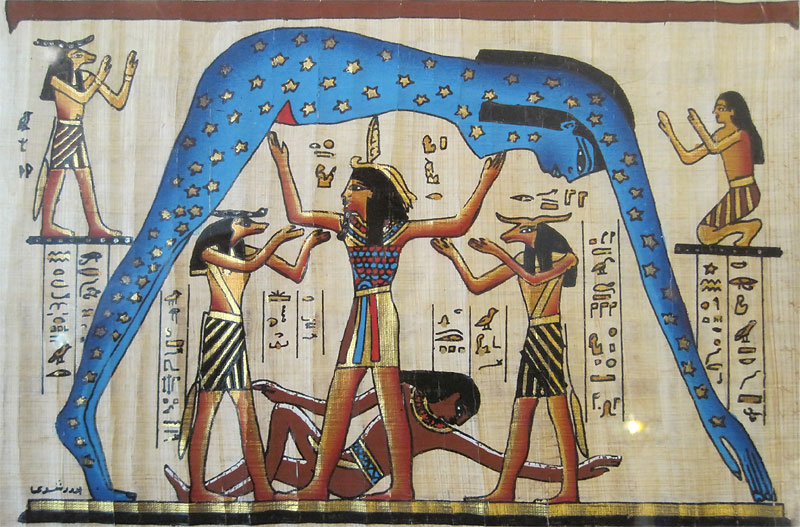
The device of the world from the ancient Egyptians
From the most ancient times, the surrounding nature was animated and deified. Among the ancient Egyptians, the sky was the body of the goddess Nuth, which lay, more precisely, stood, bent over the ground, and along which the god of the Sun Ra, who was, incidentally, the grandfather of this very Nuth, sailed on his boat. The ancient Greeks at the same place was the god of the Sun Helios, rolling across the sky in a golden chariot, well, I will not enumerate here the myths of all primitive Sumerians and Aztecs, all about the same thing, only under different names that are difficult to pronounce.
Ancient Greek philosophers were among the first to move away from the idea of man-gods with headbirds when describing natural phenomena, creating a more familiar scientific, or at least a mechanical system of the world. I do not remember all philosophers; it is believed that Aristotle personally, 300 years BC, summarized the various theories that existed at that time, formulating the first intelligible geometric model of the Universe. As an avid idealist, in his cosmology, Aristotle endowed celestial bodies with ideal proportions and ratios. The ideal and round (in the sense, spherical) Earth was in the center of the world, around it, glued to invisible crystal spheres, moving in perfect circles the Moon, the Sun and the 5 planets of the Solar System known at that time, as well as the spheres of fire, water and air, and it was all closed by the sphere of fixed stars. There was nothing material behind the celestial stellar vault, there was located the place of residence of the gods and one solid spirituality, that is, it was here that the horizon of humanity passed.
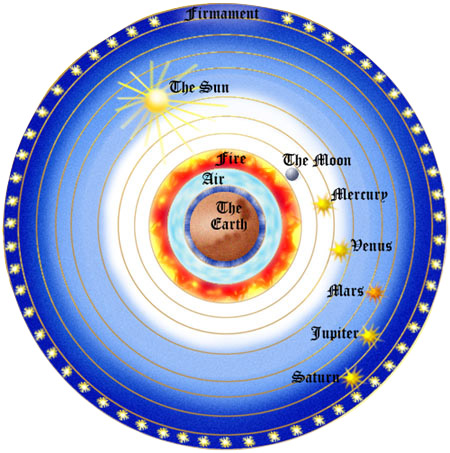
The device world according to Aristotle
But already in the time of Aristotle, people who had been observing a sufficient time for the movement of the stars in the firmament began to creep in well-founded doubts. The planets did not move in perfect circles (the concept of "orbit" was not yet invented, it was believed that the crystal sphere rotates all entirely, and the planet drawn or glued to this sphere with it). On the contrary, they wrote out across the sky visible even with the naked eye (and others had not yet met) loops.
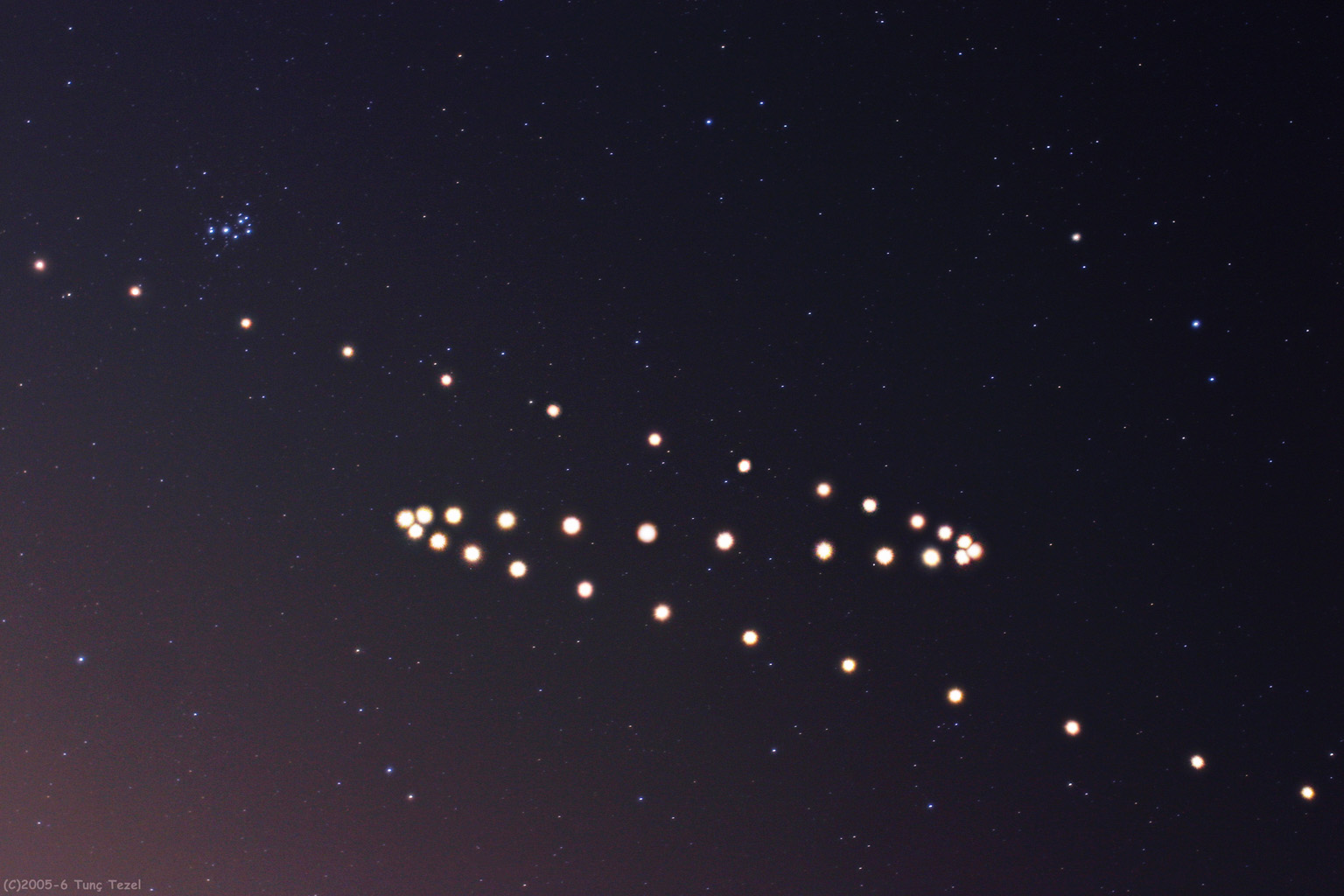
Mars movement across the sky
In the second century AD, astronomer Ptolemy created a new, improved system of star mechanics, now with epicycles ! To correct the apparent discrepancy between the motion of the planets that did not want to move along ideal circles, he introduced the concept of "epicycles" and "drifts". According to his plan, the Earth is still spherical (hello to lovers of a flat Earth from the second century AD!) And is still in the center of the Universe, and the planets (including the Moon and the Sun) move in small circles (epicycles), which, in turn , moving around the earth in circles large (drifts). The stars still rest on the immovable celestial sphere, which served as the horizon bounding our Universe from the world of spirits.
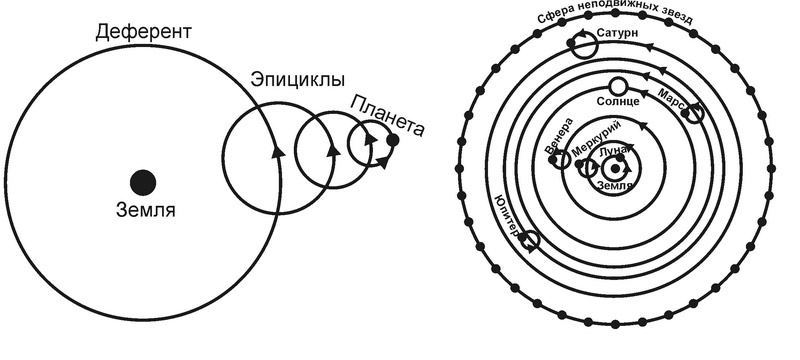
Ptolemy epicycles ( retrograde motion scheme )
The Ptolemy model existed for almost 15 centuries with practically no significant qualitative changes. Accuracy of observation of the night sky was increasing, therefore new epicycles invested in other epicycles had to be added to the scheme, and then, and finally, their number in some models could reach eighty (!), Until in the 16th century the Polish scientist Copernicus . He changed, by the way, not so much, only the Earth and the Sun in places. All the same ideal circles, all the same epicycles, which became noticeably smaller, for there was absolutely no way without them, and the same boundary of the universe is a fixed celestial sphere of stars.
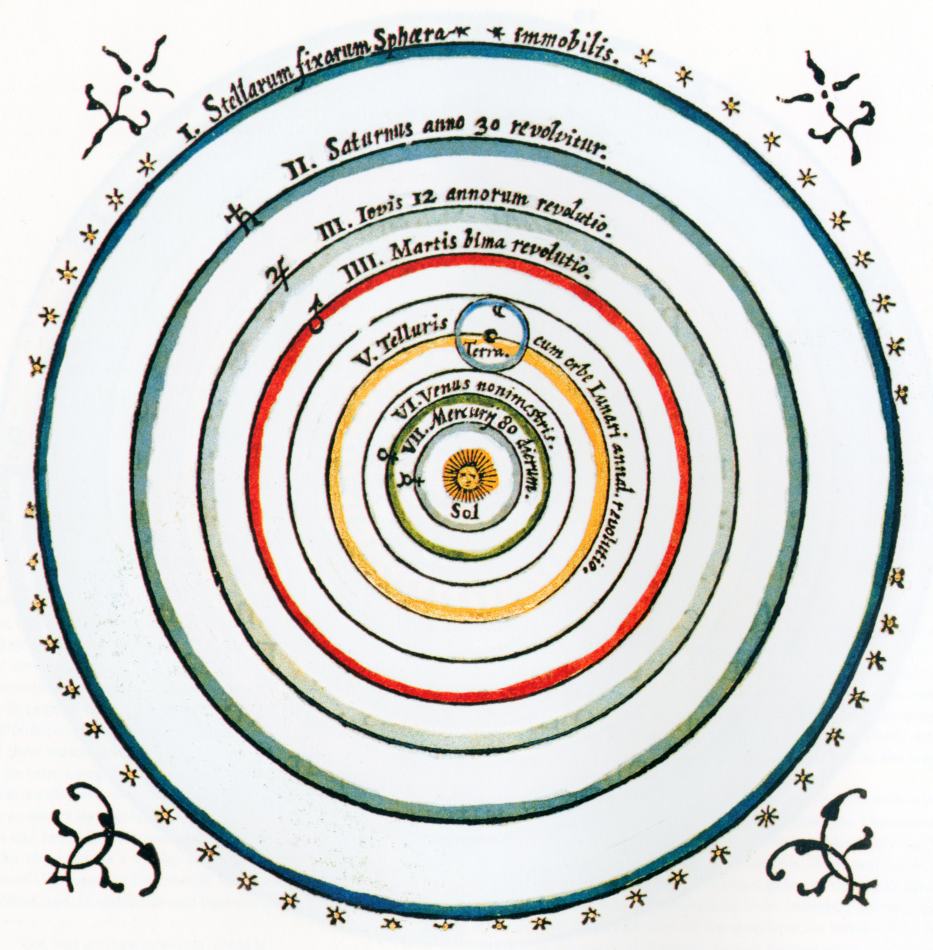
World's Copernicus system ( retrograde motion scheme )
In the eyes of a simple philistine, Copernicus turned everything upside down, although from a scientific point of view, the English astronomer Thomas Digges made a much larger revolution. But the reader of these lines surely did not even hear such a last name. Nevertheless, just Digges removed from the Copernican scheme the edge of the Universe, filling it with stars into the distance and to infinity, or, as they say, decided that "there are turtles there to the very bottom . "
It is possible that it was precisely the idea of Thomas Digges that determined the fate of the Italian Giordano Bruno, engendering in him a quite logical conclusion that does not require much effort. If distant stars are not points drawn on the crystal dome of the heavens, but bright luminaries, like our Sun, then maybe their worlds / planets revolve around these luminaries, and other creatures unknown to us may live on these planets. The Catholic Church could not tolerate such heresy. If Bruno just blurted out such a thing and calmed down, everything would be fine, but he began to play tricks with lectures all over Europe, spreading the seeds of heretical contagion from London to Venice. There he was captured, held in a Roman prison for 8 years and eventually executed.

World device according to Digges and Bruno
A similar story, by the way, happened to another Italian, Galileo, 30 years after the burning of Giordano Bruno. Galileo published a book in which he claimed that Copernicus was right and that “Earth is spinning,” and he was also imprisoned for 10 years. But Galileo was a personal friend of the then Pope, so he was not finally burned, but, on the contrary, put under house arrest, in which he remained until the end of his life. And now the most interesting thing - in 1992, Pope John Paul II officially acknowledged that the Catholic Church made a mistake, and Galileo was not guilty, because the Earth is spinning, and it is impossible even to deny the papal throne in the 20th century. At the same time, after an additional investigation, he upheld the sentence of Giordano Bruno. Togo, according to the Pope, was burned right and for the cause, no other forms of life on the planets of other solar systems have yet been discovered. That's how they will be, then come with questions of appeals, but for now, I'm sorry, such things.
On the other hand, it’s not enough to wait until the German Kepler applies his three laws of the motion of celestial bodies to the Copernican system (the most radical was the change of ideally round orbits to elliptical ones, well, I had to introduce the very concept of orbit, of course) Englishman Newton and the first to explain why the planets in principle move in orbits, and the apples fall to the ground, there is also a Frenchman Laplace a little involved in the matter, and that's all, a new scheme of the universe for another 300 years is ready.
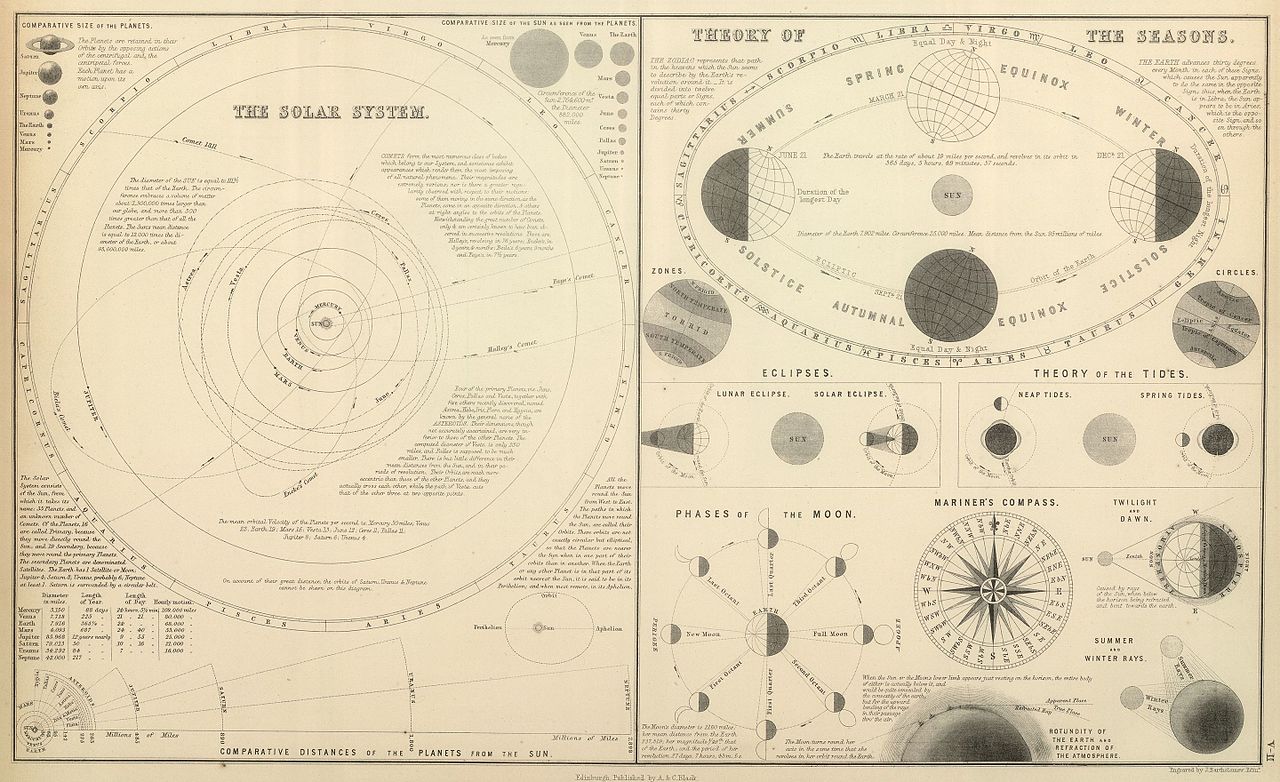
Kepler and Newton World ( larger )
Probably, this concept of a radical change in the scientific paradigm was reflected by an unknown artist of the 19th century, who stylized his Flammarion Engraving according to the canons of medieval paintings. On it, the pundit pokes his head (sort of like with his mind) the celestial sphere and finds behind her the gears controlling the mechanisms of the universe, according to modern concepts he looks into the window of the Matrix server data center.
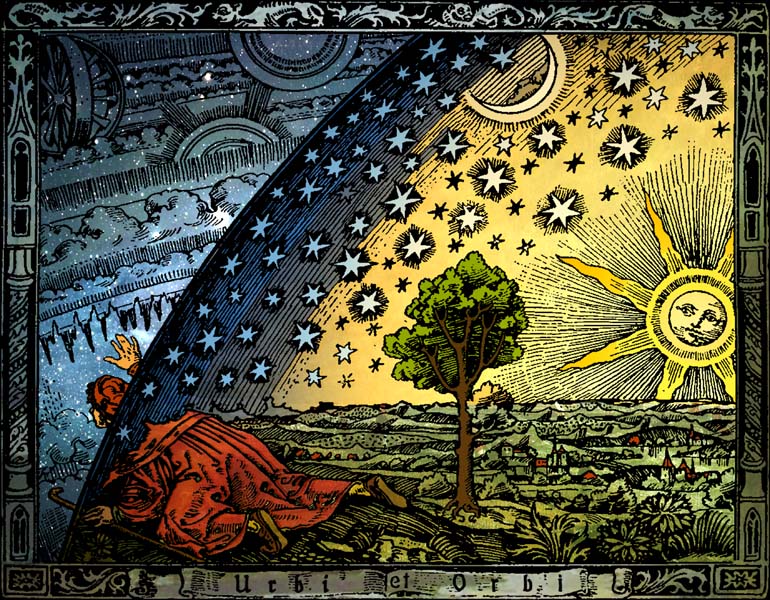
Flammarion Engraving
That is, since the time of Newton, the surrounding Universe has acquired characteristics that are quite close to modern concepts, I will explain what I mean. In the center of the world is the Solar System, in the middle of which either the Earth or the Sun is around the planet, and then there are endless spaces filled with stars, which, in turn, are also star systems with their planets. By and large, already then began to form the so-called. Copernican principle , which asserts that neither the Earth nor the Sun are any special distinguished places in the Universe. And that any other star in the same way can be declared the center of the world, and the rest of the Universe will surround it, because if space is infinite, boldly take any point and declare it a center, you will not be mistaken.
Then, in the 20s of the twentieth century, it came to be understood that the Universe is unevenly filled with stars everywhere and everywhere; instead, the stars pile up into large conglomerates called “galaxy” with huge regions of emptiness between them. Previously, the word "Galaxy" was synonymous with the concept of "Universe", and therefore was written with a capital letter, but then with the help of Hubble (then not a telescope, but just an American astronomer), it turned out that there are many other galaxies in space (now with a small letter) and ours, the Milky Way, is only one of hundreds of billions of its kind. Now, by the way, a similar situation occurs. Scientists suggest that in addition to our Universe (which is with a capital letter, and which used to mean everything – everything – everything that is and what exists), there may be many more universes (with a small one), but this is just below.
All the same Hubble, a man and a telescope, besides heaps of other galaxies, discovered the law of expansion of our Universe, that is, discovered the removal of galaxies from each other. And once the galaxies are removed, then before they were closer, and so word for word, it came to the theory of the Big Bang and we finally got a modern picture of the surrounding reality.

Modern picture of the device of the universe
Look closer, better in full size , nothing like? True, similar to the concept with which the conversation began? And everything is perfectly round again, no epicycles! Here, of course, there are some significant differences, but at first glance you are amazed how you started, so you came back. Only at a more advanced stage of knowledge, everything as Lenin (Hegel) ordered.
And yet you need to understand the differences, let's order. For a start, here we have not a model of the entire universe, but only a part of it. If we cross the theory of the Big Bang with the postulates of the Theory of Relativity, it turns out that we cannot see around us any longer than the age of the Universe, because the speed of light cannot be faster. The age is about 14 billion years, that is, you can look around for 14 billion light years and then it will not work. NB! In fact, not 14, but 46 billion light-years, I can explain in the comments why this is so, but these are superfluous details, besides not exceeding the order of magnitude.
So, instead of the scheme of the whole – the whole – the whole Universe in general, we can only depict a model of the so-called Observable Universe , given to us by Einstein in sensations that are not beyond the boundaries of the light cone. This is a section of the Universe, from which at least some signals have reached us. In the simplest case (and this is not ours, everything is straightforward, but for now we will not go deep) this area turns out to be a round bubble, that is, a sphere with a radius of 14 billion (46, if we take into account the correction) light years. Moreover, the boundaries of this sphere are expanding with time, signals to Earth come from more and more distant parts of space, with each passing year we see a light year further, the bubble of the Observable Universe is growing and the horizons of perception are moving apart.
And now a funny remark, which you can hardly think about in the hectic days. If we slightly weaken the severity of the wording, we can half-jokingly say that modern scientists "have disproved Copernicus," and his postulate at the same time. In the center of the Universe is not the Sun, but the Earth. Moreover, in each specific case - a specific place on Earth, from where observations are made. In the eye of the beholder is not only beauty, but also the whole surrounding reality, it is the Observable Universe. This means not just the Earth, and specifically you are in the very center of the world, your head (your eye, your brain) is the real center of the Universe, and this is not a beautiful metaphor, but a completely scientific point of view.

Modern picture of the universe from the point of view of the observer
On the border of the Observable Universe (which, by the way, is called the "event horizon", just like the black hole), our knowledge of the world around us ends. Strictly speaking, it is reliable scientific knowledge that ends, that is, those that can be verified and confirmed by experiment or observation. Scientists guess (they don’t know , but they guess ) that the Observable Universe is not the whole – the whole – the whole Universe. If the observer is on another planet, another star, in another galaxy, he will have his own visibility ball that does not coincide with ours. So, that big Universe can in principle be infinite in all directions and around each of its points - its own visible universe (with a small letter). You can even make a reasonable assumption that at the borders of our observable universe nothing significant changes, we see more or less evenly distributed stars and galaxies to the horizon, most likely, and all the same uniformly scattered stars and galaxies will continue to follow it. It is almost knowledge , not guess . It is impossible to know for sure, but it can be quite logical to assume if emptiness begins abruptly outside the border of the observable universe or, on the contrary, some unknown wall - stars and galaxies on our side of the border would be unevenly distributed. They would begin to form some kind of guessed structure, since stars and galaxies are everywhere everywhere, and from the outside - suddenly abruptness. But no, we don’t observe any particular structure, everything is quite evenly smeared in all directions until the end, so, most likely, beyond the horizon of observability, the substance continues to spread more or less evenly in space. There are even calculations in order to observe what we are observing, that is, the isotropic distribution of matter in the observable universe, that large surrounding Universe must be at least 100 times larger than the visible size. It may be completely infinite, but we know for sure that at least two orders of magnitude more than our foreseeable. Minimum.
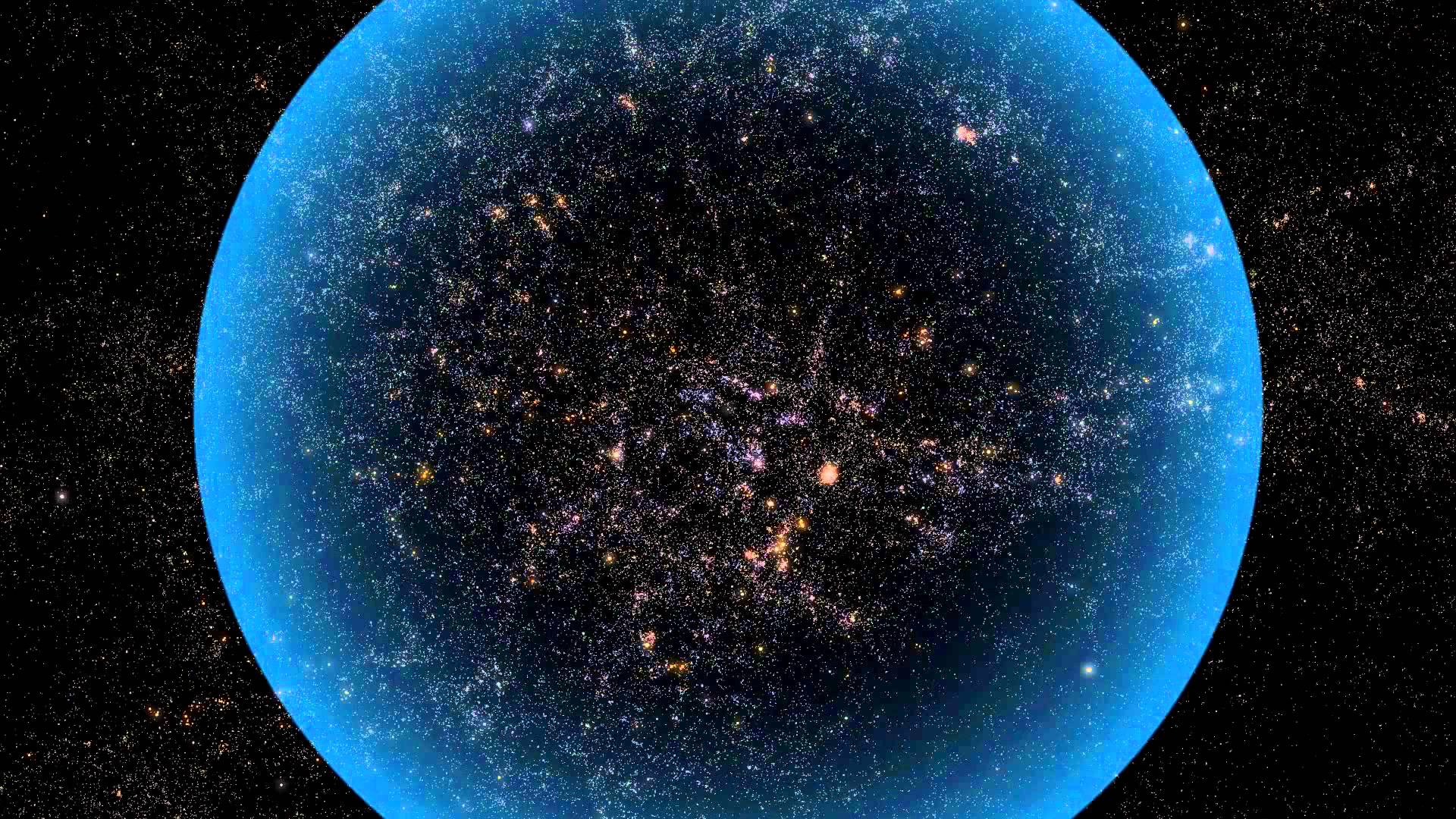
No wall again
But what next? Then, I repeat, it is no longer a field of scientific knowledge, you need to clearly understand: here the field of fantasy and conjecture begins. That is, it can not be that we discover all the existing secrets of nature, and that's that, we will never discover anything interesting! You can think of hypotheses (trying to stay within the framework of scientific assumptions) that may be there, beyond the horizon. Will the next round of the spiral of knowledge repeat, will we ever find something more than the whole Universe? Perhaps some Multiverse? The options may be different, let's fantasize, not forgetting that we are exactly what we fantasize scientifically.

Multiverse?
The most famous option to date is derived from the Theory of Inflation . This is not even a fantasy, but a fully working mainstream hypothesis, which can eventually find indirect and even direct observational evidence, and work in this direction is already underway right now by ground and space observatories. Let me remind you in a nutshell.
Some dark and cold (and practically empty) proto-universe, due to random quantum fluctuations, began to expand exponentially in all directions. Why and how did this happen, and what was this proto-Universe, and why was it empty - there are only solid fortune telling. But then in some place (quite possibly in many places) this expansion began to slow down, because it reached the bottom of the potential well, at this stage "due to friction / braking forces" a lot of energy was released, which marked the beginning of the hot Big Bang we present it today. Particles of hot matter fell out of the vacuum (condensed) due to a phase transition from abrupt deceleration. About "braking", this is of course a joke, in the sense of analogy, nothing literally slowed down there, like a tire on asphalt , but as an analogy, everything is very similar.
Theoretically, such a "braking" could occur in different random places, possibly initially infinite and exponentially expanding universe, small bubbles of local large explosions flashed here and there, with different conditions and even different physical laws inside. Some bubbles probably collapsed back. If too much matter condensed into the vacuum of space, their gravity would have to be pulled back, to a point, to a singularity. If too little matter fell, its mutual gravity was too weak, and the bubble stretched to hell in all directions, the still infinite universe, and inside the bubble, by and large, there is a void, only somewhere somewhere a photon will slip through, then an electron is random. In our case, it turned out very clearly and finely tuned (anthropic principle, aha), matter turned out to be just enough to start inflating the bubble of the local Universe originating from the local Big Bang, and continue to inflate further and further, though with deceleration, but then mysterious Dark Energy comes into play, and the bubble has already started to swell with acceleration, and what this will lead to is not yet clear.
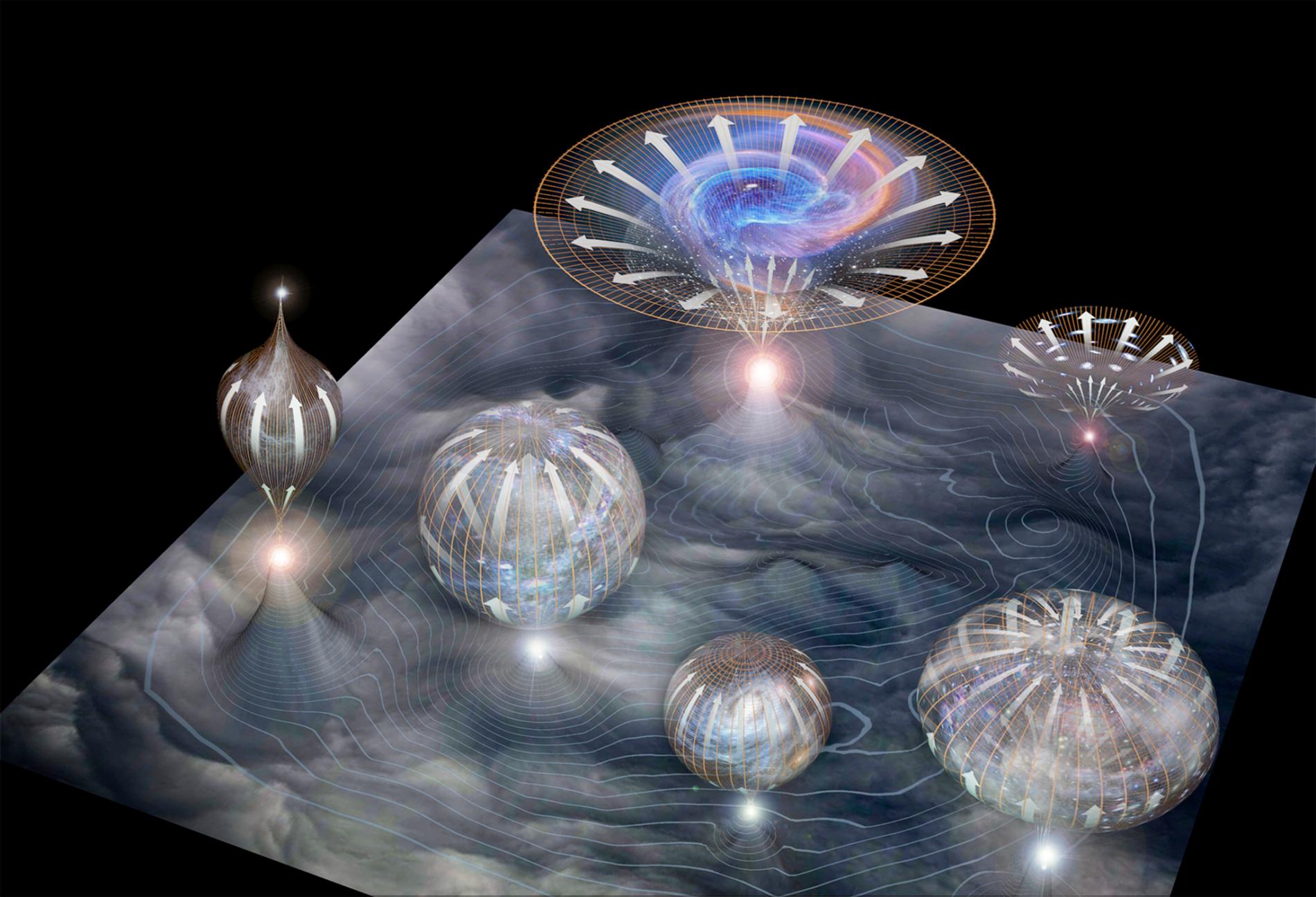
The work of the inflationary multiverse
Here you have one of the simplest theories of the Multiverse. Some kind of huge (possibly infinite) dark and cold proto-Universe, expanding in all directions (maybe even into itself, but here, I repeat, we know very little exactly, so fantasize even to the fall), in which then and there and then there are swelling the bubbles of ordinary universes, one of which turned out to be ours.

Multiverse!
More precisely, there is a theory of multiple universes even simpler than the above. Our bubble that has arisen in our local Big Bang, too, strictly speaking, can be infinite inside. No need to think that this is a natural round bubble with a border of film, as in the figures, like an air bubble in a champagne glass. Naturally, this is all fantasy artists. This Universe with our laws of physics and tuned to our senses can also be infinite in all directions, although it is difficult to imagine how one infinity of the Universe can be "all inside" another infinity of the Multiverse. That is, to be smaller than her, since she fits all inside, and at the same time remains infinite. But mathematics does not forbid, and what physics says is still not clear to us on such scales.
And if our universe is infinite in its bubble, then we estimate it by eye. It is believed that in the observable universe there are about 10 80 elementary particles and about 10 90 photons, most of which are relict. Everything is very, very roughly, of course, but in these matters the order is there, two orders here do not significantly change anything. The number of configurations in which these 10 80 particles can be folded is many times larger than the particles themselves, but also some definite, albeit inconceivably huge number. However, the concept of "unimaginable" is not very appropriate here, everything is easy enough imaginable, I advise you to read my really unimaginable things to read my article " The Graham Number on Fingers ", although it is recommended to do this with great care (!).
And infinity is a terrible thing, any, even unimaginably complex configuration in an infinite Universe will be forced to repeat, and an infinite number of times. Because any, even the most brain-breaking number in the end ends, and still have to reproduce the interposition of particles again. That is, if we fly away from our Observable Universe sufficiently ( difficultly ) far away, we will sooner or later stumble upon the exact same configuration as ours, we will fall into the exact same foreseeable universe. True, the move will have to be much faster than the speed of light, which is impossible, and so - this is the simplest model of the Multiverse, an infinite Universe with the same laws of physics, divided into balls of visible universes, separated by a horizon of events and periodically repeated. Unlike the inflationary Multiverse, where in each bubble, theoretically, there can be different laws of physics, but if there are an infinite number of them, then there is also no repetition.
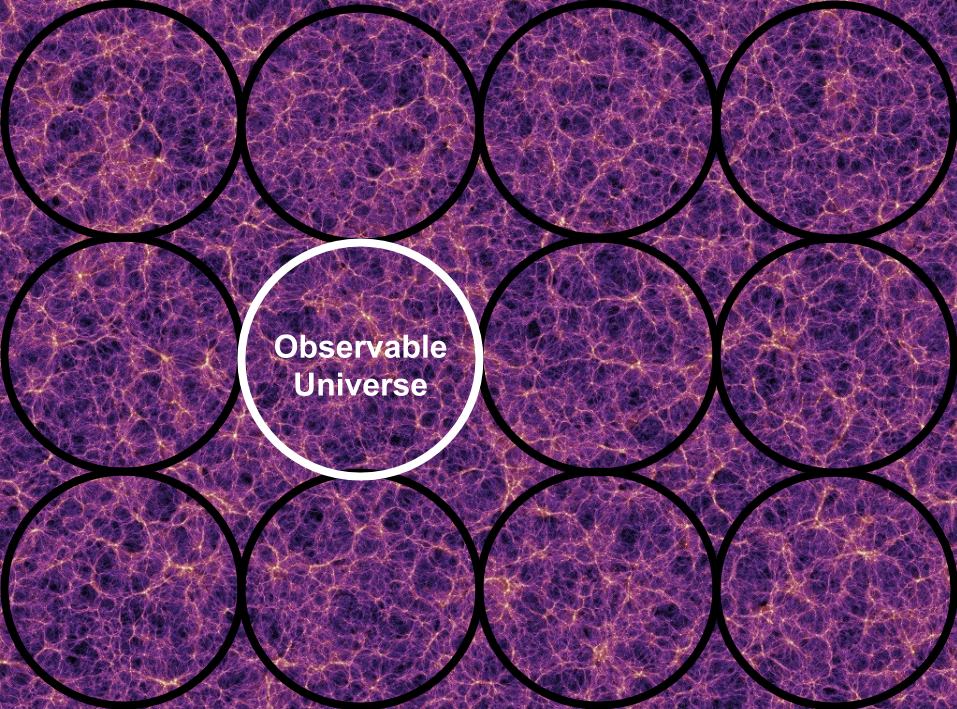
The easiest Multiverse
An even more cunning idea of the construction of the Multiverse follows from the postulates of quantum mechanics. There it is believed that any observation collapses the wave function, and Schrödinger's cat in the box is either alive or dead. However, there are interpretations that at the moment of observation the Universe is divided in two (or into any number of possible outcomes) and every second we generate a crazy number of branched parallel universes, each with its own experiment outcome. These universes are no longer located as infinitely as universes in inflation theory. They are all right here, somewhere close by, perhaps in the meter from ours, only to get there (for now) is impossible, for they are separated from us by some higher dimension or something from this area.
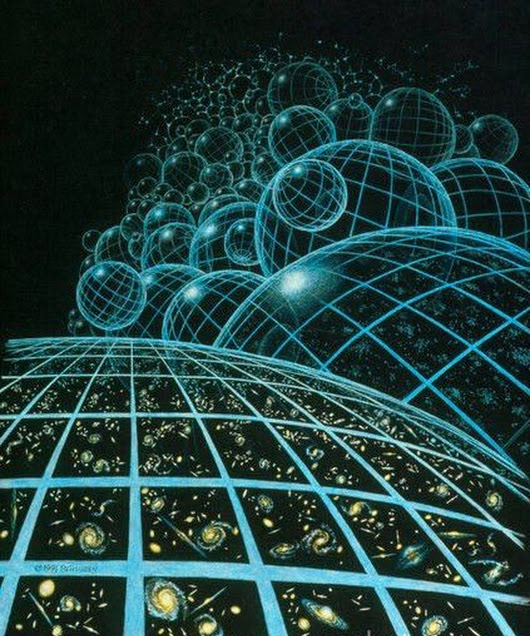
Multiworld Multiverse
By the way, about the higher dimensions. If they exist and String Theory is correct, we get another possibility of the existence of parallel universes. Where the higher dimensions are collapsed into other configurations (the problem of the landscape), the door is always open for posting 10,500 different bundles of the Calabi – Yau space, which means the potential presence of such a number of parallel universes around.
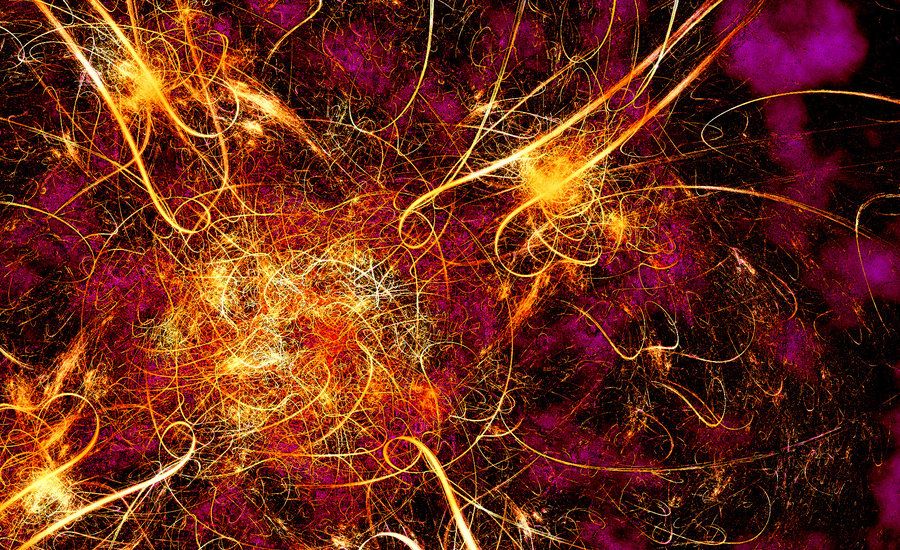
Multiverse String Theory
In general, there are a great many concepts of the multiverse. For example, individual universes can be separated not in space, but in time. There can be a whole set of so-called. cyclic multiverse. For example, the Universe explodes with the Big Bang, begins to scatter in all directions, but then it slows down, turns backwards, shrinks almost to its original size, now it collapses into a singularity, and then bang! - the new Big Bang. And so in a circle. Different universes are obtained, because you cannot get from one to another just like that, and in sum, the Cyclic Multiverse.
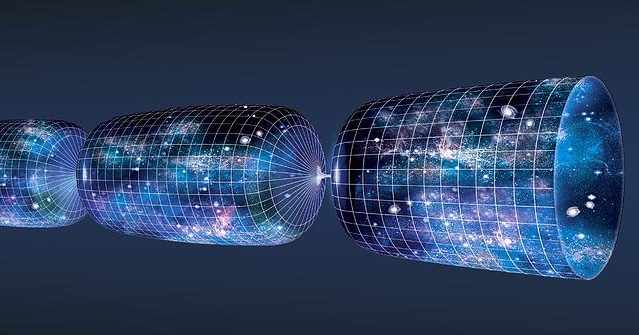
Cyclic Multiverse
— , , , , , — .

— , , – , , , , — .
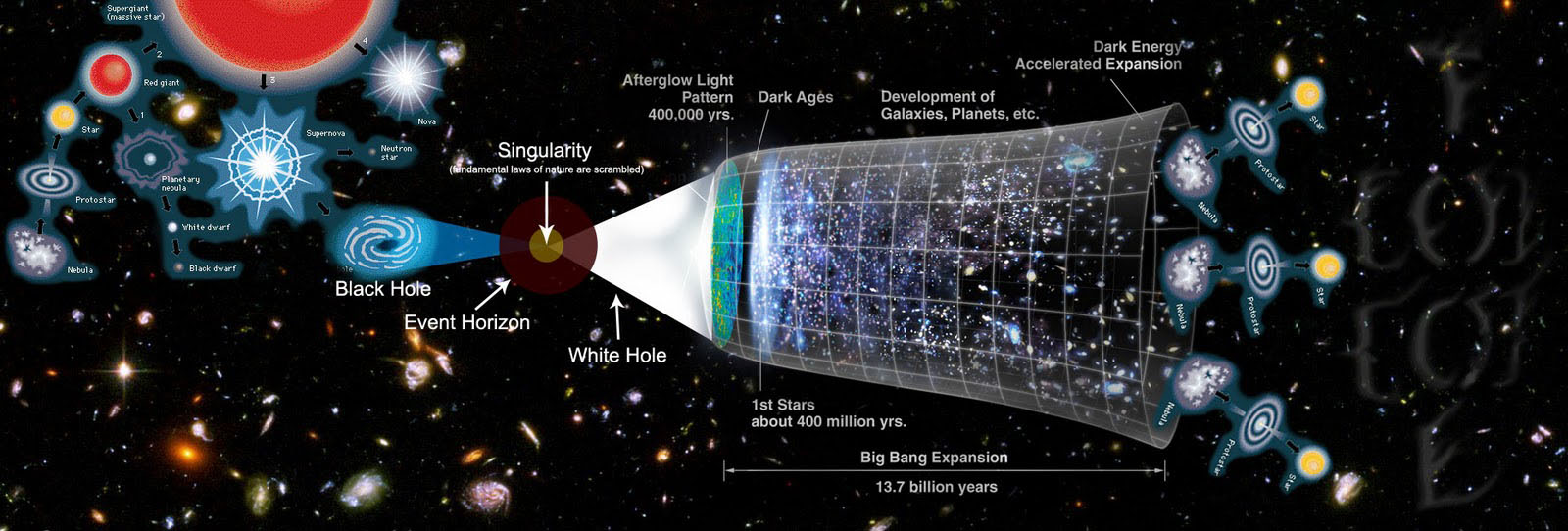
, . , , , . , . – , , , , ? , . — (, , !), . , , . , – ?
PS Other posts from the series on the fingers of my blog. And yes, quite a while ago I was not at Habré!
')
Source: https://habr.com/ru/post/417989/
All Articles